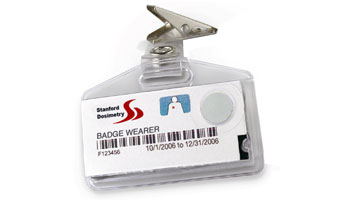The Dosimeter Badge and Radiation Safety
 Radiologists, even when they follow the most stringent safety procedures, are already working with an energy for which there is no safe exposure limit. There is always risk involved with exposure to radiation, and there’s absolutely no way to eliminate that risk fully.
Radiologists, even when they follow the most stringent safety procedures, are already working with an energy for which there is no safe exposure limit. There is always risk involved with exposure to radiation, and there’s absolutely no way to eliminate that risk fully.
However, the standards set for exposure limits for radiologists in the course of their occupation are designed to be reasonable. For example, Stanford uses radiation limits that were recommended by the International Commission on Radiological Protection and the National Council on Radiation Protection and Measurements. These allow occupational doses to the whole body to reach 5 rems per year. The eyes can be exposed to a maximum of 15 rems per year and shallow dose radiation on the skin and extremities can reach 50 rems per year.
It’s important to keep in mind how high these doses actually are. Non-occupational radiation doses are recommended by the same sources as 0.1 rems per year to the entire body. There are no standards for the lenses of the eye or shallow doses of the skin.
While there are different requirements, most states have their own set of standards that require radiologists to wear a dosimeter badge that gives information on how much radiation exposure has actually occurred.
In some cases, some of the workers who work around radiation may not be required to wear a badge. For instance, in Nevada, if a facility can establish that someone who works around radiation will not receive any more than 500 millirems in total radiation over the entire year, that individual will not be required to wear a dosimetry badge.
It’s important to understand whatever standards apply and, of course, to ensure that x-ray technicians and anyone else who works around the radiology equipment is in compliance with those standards. That compliance can go a long way toward preventing health issues that result from exposure to radiation. The badges make it possible to determine the average dose of radiation that any worker receives by testing the badge after it is worn for a given period.
RADIATION DOSE DOCUMENTATION
In some cases, it may be necessary to keep employees who would normally be working around radiation away from it unexpectedly if they receive a greater dose than was anticipated and can no longer work within the established limits.
While it is unfortunate, there are sometimes situations where employees decide not to report information or where they attempt to remain in their jobs, even after they have received too much radiation already and need to be prevented from getting any more radiation dosing throughout the year. It’s important to make certain that documentation is thorough and that employees are required to provide whatever materials they need to offer – used badges, for instance – consistently. This enables the facility to keep a good policy in place and to keep in compliance with any state or other standards that need to be followed for employee safety.
While radiologists and other workers who do a lot of work around a great deal of radiation will generally be very good about monitoring what they're dosed with, employees who do not spend a great deal of time around radiation may be more difficult to track.
It’s imperative that employees are educated about using badges, that they track their radiation exposure as required and that, if they start to do more work around radiation than they normally would, that it is reported and noted. With good policies in place and good record keeping, radiation dosimeter badges can play a significant role in ensuring that employees don't receive more radiation than is permissible over the course of a year.
https://web.stanford.edu/dept/EHS/prod/researchlab/radlaser/Hospital_Guidance_document.pdf
Recent Posts
-
TIPS FOR USING THE PIGG-O-STAT X-RAY IMMOBILIZER
TIPS FOR CHILD COOPERATION AND TRAUMA REDUCTION Let's be honest here: most young children ar …Feb 17th 2024 -
The Dosimeter Badge and Radiation Safety
Radiologists, even when they follow the most stringent safety procedures, are already working …Feb 17th 2024 -
STEALTH-CORE & STEALTH-COTE ARTIFACT-FREE POSITIONING SPONGES
Eljay now carries Techno-Aide's NEW revolutionary design, which ELIMINATES ghosting and line a …Feb 15th 2024
